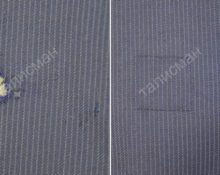Every fashionista has jeans in her wardrobe; they are comfortable and durable. Mothers actively dress their children in denim clothes. But despite their strength, jeans sometimes tear, and in the most unexpected places. “Hands growing from where necessary” and female ingenuity will help here.
We sew up holes on jeans depending on the part of the product
If a hole in the knee can be turned into a creative and fashionable addition to a modern look, then with a piece torn out from the butt this option will not work.
Let's mend the hole in the jeans between the legs
 Holes appear in places of greatest friction. For extensive abrasions, a patch is indispensable. It’s great if there are scraps left after shortening the trousers, but if not, then a scrap of a suitable shade can be found in a textile store. When choosing threads, you need to take into account their resistance to fading.
Holes appear in places of greatest friction. For extensive abrasions, a patch is indispensable. It’s great if there are scraps left after shortening the trousers, but if not, then a scrap of a suitable shade can be found in a textile store. When choosing threads, you need to take into account their resistance to fading.
You must act with the utmost care. The patch is applied from the inside out. Depending on the capabilities of machine or hand stitching, the edge of the patch is sewn to the product.The frayed edges of the hole are sewn to the patch using the plastering method. The seams are laid close to each other. It doesn’t matter if the machine does not have a reverse sewing function, you can simply unroll the product before the next seam. With a conscientious approach, the patch will be almost invisible.
Advice! Leather crotch patches “a la cowboy” look very impressive; if you are comfortable with a needle, you can easily upgrade old jeans into a new interesting wardrobe item.
Instructions: How to manually repair a hole in denim trousers at the knee
 A hole in the knee is not a problem for young people, but a trendy accessory. Children's pants can be decorated with patches, even in contrasting colors. But with my husband’s trousers, you will have to try so that the hole leaves an inconspicuous mark. The same thing will come to the rescue here. Step by step it looks like this:
A hole in the knee is not a problem for young people, but a trendy accessory. Children's pants can be decorated with patches, even in contrasting colors. But with my husband’s trousers, you will have to try so that the hole leaves an inconspicuous mark. The same thing will come to the rescue here. Step by step it looks like this:
- A patch larger than the hole is glued to the left side of the product. It is convenient to use glue for this.
- The entire surface of the damaged tissue is covered with frequent stitches located close to each other, the so-called plastering is carried out.
- If the damage is extensive, then you should be patient; you may have to fill the hole with lines in several approaches.
- We make the stitches even and without tightening so that the patch does not look like a dried mushroom.
For newbies! The adhesive is applied with the rough side down and ironed with a hot iron through a layer of fabric.
How to quietly patch a hole in your butt in denim pants
 The simplest and most effective way to hide a torn patch on trousers in the buttocks area is to apply an applique. An alternative option is embroidery, but there aren’t many of us who love embroidery, so let’s consider the first option.The applique can be made from denim, beautifully decorating the patch with contrasting stitching.
The simplest and most effective way to hide a torn patch on trousers in the buttocks area is to apply an applique. An alternative option is embroidery, but there aren’t many of us who love embroidery, so let’s consider the first option.The applique can be made from denim, beautifully decorating the patch with contrasting stitching.
Modern machines have a rich arsenal of decorative seams; all that remains is to choose the fabric to decorate the hole to your liking. Modern fashion trends are so diverse that lace and woolen elements will look organic.
Advice! When eliminating a hole, try not to focus attention on it, sew on appliques randomly and larger, as if it was intended by the designer.
How to beautifully sew a tear in fabric or seams on jeans trousers
Jeans may have straight tears, cuts or L-shaped damage.
When sewing them up, the main thing is not to pull the edges too tightly; the stitches are made close to each other according to the figure eight principle.
The threads are selected to match the fabric to hide the traces of past damage.
Instructions: How to decorate using sewing finishing elements (embroidery, patch)
Ethnic style jeans look interesting. You can use a variety of colors here. The threads need to be chosen thick so that the applique turns out to be embossed.

Advice! To make the embroidery process easier, use a small hoop.
For men's trousers, discreet embroideries and appliqués are popular.
In handicraft stores you can find appliqués and patches for any gender and age, almost all of them are adhesive-based. That is, you just need to attach it to the front side of the product and iron it with a hot iron.
Important! To prevent purchased stickers from coming off during washing, machine stitch them along the edges.
Other methods to disguise a rip (altering trousers)
 A hole can be turned from a disadvantage into an advantage. To do this, you just need to add slits on the legs. For naturalness, you can make a fringe.It is more convenient to do this with a needle, carefully pulling out the threads. Tears with a processed edge will look interesting. For those who like to draw, you can upgrade the hole to a figured hole. For example, cut out the first letter of a name or a hieroglyph, and then finish the edge with a decorative stitch in a contrasting or matching tone.
A hole can be turned from a disadvantage into an advantage. To do this, you just need to add slits on the legs. For naturalness, you can make a fringe.It is more convenient to do this with a needle, carefully pulling out the threads. Tears with a processed edge will look interesting. For those who like to draw, you can upgrade the hole to a figured hole. For example, cut out the first letter of a name or a hieroglyph, and then finish the edge with a decorative stitch in a contrasting or matching tone.
If there is a vertical tear, you can sew a zipper into the hole. And if you hide the hole with a patch pocket (you can take it from other old pants), then the jeans will be intact and their functionality will increase.
If the trousers could not be saved, or the restoration went wrong, the trousers can always be upgraded into breeches or short shorts. It is easy to decorate the edge of the product with fringe or sew on cuffs made of colored fabric.
Tips on how to quickly close torn areas of a product if you don’t have time for handicraft tricks
 You are already on the threshold, in a terrible hurry. Have you crouched down behind your fallen keys and heard a suspicious crash? or there was an accident at work and the trousers were torn. An elongated cardigan or, if it’s hot, a long, loose-fitting blouse will help hide the hole in the top of your pants.
You are already on the threshold, in a terrible hurry. Have you crouched down behind your fallen keys and heard a suspicious crash? or there was an accident at work and the trousers were torn. An elongated cardigan or, if it’s hot, a long, loose-fitting blouse will help hide the hole in the top of your pants.
You may not have such things with you outside the house, so you will have to resort to other tricks:
- The split seam can be stapled using a stapler.
- If the bottom of the trouser leg is torn, you can tuck the trousers symmetrically, as if that’s the way it should be.
- The hole in the hip area can be easily draped by tying a stole around the waist.
Jeans are perhaps the most difficult thing to repair; if you have imagination and perseverance, you can not only mend your favorite pants, but also turn them into a sewing masterpiece, a unique item in your wardrobe.


 0
0





